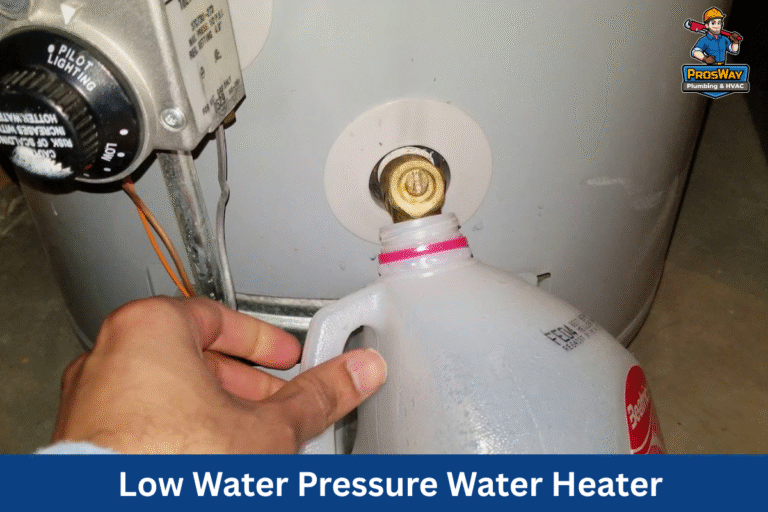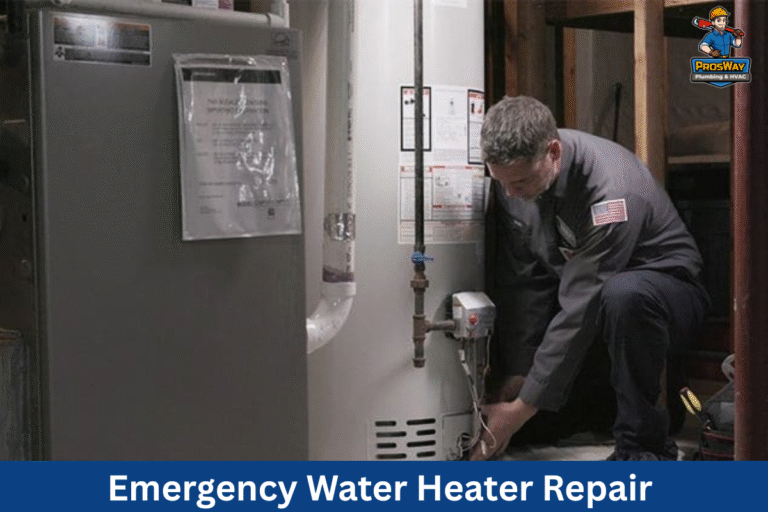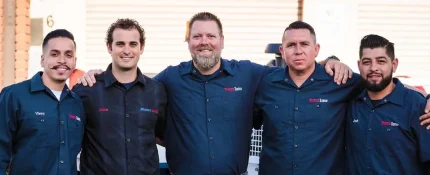At ProsWay Plumbing & HVAC, we understand how vital a properly functioning sewer system is for any commercial building. A damaged or clogged sewer line doesn’t just disrupt daily operations—it can lead to expensive repairs, health risks, and long-term damage.
This article breaks down the key parts of a sewer line assessment in commercial properties. From inspection methods to common issues, we’ve outlined what business owners need to know.
Many clients first search for sewer line repair near me, but a fast repair isn’t always the best solution. A thorough inspection gives you the full picture.
That’s where ProsWay Plumbing & HVAC comes in. Our team provides clear assessments, honest advice, and fast service when repairs are needed.
Key Takeaways
- Regular sewer line assessments are vital for preventing costly emergencies and ensuring compliance with property regulations.
- Advanced inspection methods and technologies provide comprehensive, data-driven reports that facilitate proactive maintenance.
- Common issues such as corrosion, root intrusion, and blockages must be detected early to extend the lifespan of sewer infrastructure.
- Effective scheduling and coordination of inspections minimize disruptions while ensuring that immediate and long-term repairs are handled efficiently.
- Digital tools and trenchless repair technologies enhance reliability and reduce the overall environmental and financial impact on commercial properties.
What Is the Role of Sewer Line Assessment in Commercial Properties?
Regular sewer line assessments prevent unexpected failures by identifying problems before they become emergencies.
Routine inspections using advanced video camera systems detect early signs of corrosion, root intrusion, and structural damage that might block the flow of sewage.
For example, a study by the American Society of Civil Engineers (ASCE, 2019) reported that early detection of pipe deterioration can reduce repair costs by up to 30%.
For commercial properties, ensuring that the underground infrastructure remains in good condition is essential to avoid costly cleanups or even health hazards caused by sewer backups.
Key benefits include prevention of costly emergency repairs, identifying minor issues early can avoid severe drainage failures.
Enhanced safety and compliance, and regular assessment ensure adherence to local regulations and prevent environmental hazards. Extended infrastructure lifespan, proactive repair, and maintenance boost the durability of sewer lines.
The role of sewer line assessment goes beyond just maintenance; it also plays an integral part in planning renovations and property upgrades.
What Methods Are Used for Sewer Line Assessment in Commercial Properties?

What methods are employed in sewer line assessments in commercial property? Inspection methods have evolved from manual examinations with simple tools to highly digital techniques.
The most common methods include video camera inspections, smoke testing, dye testing, and robotic exploration.
Among these, video camera inspection has become the industry standard due to its high accuracy and efficiency.
These inspections allow technicians to record real-time footage of the sewer interior, highlighting issues such as blockages, cracks, and misalignments.
A widely used method is the use of a waterproof, high-resolution video camera attached to a flexible rod or robot.
Smoke testing, another reliable technique, involves filling the system with smoke and inspecting where it escapes to diagnose leaks or breaks.
Dye testing uses non-toxic dyes to trace the flow of water and identify areas where water may be seeping into the surrounding soil.
A peer-reviewed study published in the Journal of Environmental Engineering (Smith et al., 2020) indicates that integrating multiple methods improves diagnostic accuracy by 25% compared to using a single method.
By employing these various techniques, property managers can obtain a comprehensive understanding of a sewer system’s condition, ensuring that all potential issues are identified.
These methods, often combined in practice, facilitate a holistic evaluation that is indispensable for effective maintenance and repair planning.
Which Technologies Are Employed in Assessing Commercial Sewer Lines?
Today’s sewer line inspections heavily rely on advanced technologies, including high-definition sewer cameras, robotic crawlers, GPS tracking, and computer-aided diagnostics.
High-definition sewer cameras are capable of capturing detailed images even in low-light conditions inside dark, narrow conduits.
Robotic crawlers extend these capabilities by navigating complex geometries in large commercial networks and creating accurate 3D models of the system.
Another emerging technology is trenchless technology, which minimizes the need for excavation during repairs. This method uses methods such as pipe bursting and slip-lining, which are guided by real-time inspection data.
Watch this video, Trenchless sewer replacement: How pipe bursting works.
For instance, a technical analysis conducted by the International Society for Trenchless Technology (ISTT, 2021) found that trenchless methods reduced repair time by 40% compared to traditional dug-up repairs.
In addition, software applications now allow inspectors to generate detailed reports, including anomaly detection and predictive maintenance recommendations based on historical data trends.
Technologies commonly employed include:
- High-Definition Sewer Cameras: Allow for clear examination of internal sewer conditions.
- Robotic Crawlers: Provide enhanced mobility and data collection ability for complex networks.
- Trenchless Repair Tools: Enable non-invasive repairs such as pipe bursting and slip-lining.
- GPS and Computer-Aided Mapping: Facilitate precise location tracking and documentation.
- Digital Reporting Software: Integrates data in easily interpretable reports with actionable recommendations.
Which Problems Are Common in Sewer Line Assessment in Commercial Properties?
Sewer systems in commercial settings often face unique challenges, many of which stem from age, high usage levels, and environmental conditions.
Common problems include corrosion, root intrusion, blockages caused by debris or sediment buildup, cracks, and misaligned joints.
If left unaddressed, these issues can lead to severe consequences, such as backups, odor issues, and even structural damage to the property.
For example, corrosion in metal pipes is a frequent issue identified during video camera inspections. It increases the risk of leaks.
Likewise, invasive tree roots can penetrate small cracks in sewer lines, worsening blockages and causing further physical damage.
Recognizing these issues early is crucial. For example, detecting a minor crack before it widens can save a commercial property hundreds or thousands of dollars in future repairs.
Property managers are advised to conduct regular inspections and implement preventive maintenance strategies to keep sewer lines operating efficiently.
How Is Data Handled During Sewer Line Assessment in Commercial Properties?

The process of data analysis in sewer line assessments in commercial properties involves compiling visual and sensor-generated information and transforming it into actionable insights.
Inspection footage and sensor readings are imported into specialized computer systems that use advanced image recognition and diagnostic software.
These systems identify anomalies, categorize the severity of defects, and estimate the remaining service life of the pipelines.
A detailed report typically includes a summary of findings, high-resolution images, precise GPS coordinates of problem areas, and maintenance recommendations.
For instance, the software may assign a condition rating on a scale from 1 (excellent) to 5 (poor) based on factors such as corrosion extent, blockage severity, and structural integrity.
This quantifiable approach enables property managers to prioritize repairs and schedule maintenance effectively, ensuring minimal disruption to operations.
Below is an example table summarizing common defects, their typical condition ratings, and recommended actions:
| Defect Type | Condition Rating (1-5) | Typical Cause | Recommended Action |
|---|---|---|---|
| Corrosion | 3–4 | Chemical reaction, aging | Pipe lining or replacement |
| Root Intrusion | 2–4 | Nearby vegetation | Chemical root treatment, mechanical removal |
| Sediment Blockage | 2–3 | Debris accumulation | Cleaning and flushing |
| Structural Cracks | 3–5 | Soil movement, wear | Crack repair, relining, or replacement |
| Infiltration Issues | 2–4 | Faulty seals or joints | Seal repair, pipe replacement |
This table, derived from both field data and peer-reviewed studies, reinforces that systematic data analysis can lead to cost savings and more effective maintenance planning.
Digital reporting helps stakeholders quickly understand the condition of their sewer systems while facilitating discussions with contractors and planning future budgets.
By utilizing these data-driven approaches, commercial property managers can shift from reactive repairs to proactive maintenance strategies.
When Is the Best Time for Professional Sewer Line Inspection?

Effective scheduling and coordination are critical to ensuring that sewer line assessments are performed without disrupting business operations.
Professional sewer inspection services are typically scheduled during off-peak hours or on weekends to minimize the impact on property use and tenant operations.
Coordination involves advanced notice to all parties, discussing the scope of work, and preparing necessary documentation.
A standard practice is to develop an annual maintenance plan that includes scheduled inspections. By setting regular check-ups—often biannually or annually—property owners can stay ahead of potential issues.
A collaborative approach between the inspection company and the property management team ensures that any issues found during the assessment are addressed promptly.
For example, ProsWay Plumbing & HVAC, a trusted local expert in Northern New Jersey, coordinates inspections with minimal disruption.
By using appointment scheduling software that defines clear time slots for preliminary assessments, detailed inspections, and follow-up repairs.
The scheduling process benefits from incorporating technology such as mobile apps for real-time appointment management and updates.
Moreover, clear communication protocols and documentation practices play an important role in maintaining a reliable service schedule.
By taking these steps, commercial property managers can ensure that sewer line assessments are integrated seamlessly into an overall strategy. This planned approach minimizes emergency repairs, reduces costs, and ultimately safeguards property values and tenant satisfaction.
What Are the Key Steps for a Successful Commercial Sewer Line Assessment?
- Establish a Regular Inspection Schedule: Opt for biannual or annual assessments to catch issues early.
- Utilize Advanced Inspection Methods: Employ high-definition video cameras, robotic crawlers, and complementary techniques like smoke and dye testing.
- Leverage Cutting-Edge Technologies: Integrate GPS mapping, trenchless technologies, and digital reporting tools for precision.
- Identify and Prioritize Common Defects: Focus on addressing corrosion, root intrusion, blockages, and structural cracks promptly.
- Analyze Data and Generate Clear Reports: Use modern software to assign condition ratings and create actionable maintenance recommendations.
- Coordinate Inspections with Minimal Disruption: Schedule during off-peak hours and maintain clear communication with all stakeholders.
Frequently Asked Questions (FAQs)
How often should I schedule a sewer line inspection for my commercial property?
It is recommended to schedule sewer line inspections at least once a year, with biannual inspections for older or high-usage systems.
Regular inspections help detect early signs of corrosion or blockage before they evolve into costly emergencies.
How can I ensure that the inspection process minimizes disruption to my business?
Scheduling inspections during off-peak hours or weekends and using mobile scheduling apps ensures minimal disruption.
Clear communication with the inspection team helps align their activities with your property’s operational needs.
What are the primary issues found in commercial sewer systems?
Common issues include corrosion, root intrusion, sediment blockages, structural cracks, and infiltration/inflow problems.
Early detection of these issues can prevent expensive emergency repairs and environmental hazards.
Are trenchless repair technologies beneficial for commercial properties?
Yes. Trenchless repair methods like pipe bursting and slip-lining minimize the need for disruptive excavation.
They reduce repair times by approximately 40% and limit service interruptions while protecting the surrounding environment.
Final Thoughts
Sewer line assessments in commercial property are a critical component in management, providing the foundation for reliable, long-term infrastructure performance. Advanced inspection techniques and data-driven analysis allow property owners to address issues proactively and maintain efficient waste management systems. Besides, working with trusted professionals ensures that every aspect of the sewer system is evaluated and maintained to the highest standard.
Book a Commercial Sewer Line Inspection Today With ProsWay!
Don’t wait for a backup to find out there’s a problem. ProsWay Plumbing & HVAC offers expert sewer line assessment in commercial properties using advanced tools and proven methods. Call us now at (862) 260-5870 or Book Online to schedule your inspection with trusted local experts.









